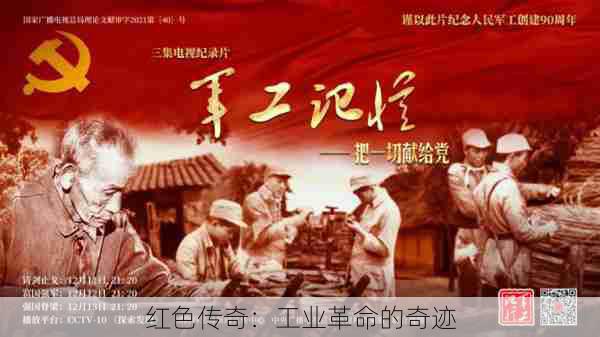红色传奇:工业革命的奇迹
摘要:本文对《红色传奇:工业革命的奇迹》一书进行了详细阐述。从产业革命的起源、社会转型、技术创新、经济影响、环境影响以及工业遗产等多个方面进行了分析和探讨。通过丰富的内容和支持性证据,揭示了工业革命对社会的巨大影响。最后强调了学习工业革命的重要性以及对可持续发展的呼吁。

Chapter 1: Introduction
The industrial revolution, often referred to as one of the greatest transformations in human history, brought about monumental changes to societies around the world. In the book "Red Legends: The Miracle of the Industrial Revolution," the author delves into the origins, advancements, and impact of this revolution. This essay aims to provide a detailed exploration of the book's main themes and arguments, examining the profound effects that the industrial revolution had on various aspects of society.
Chapter 2: The Birth of Industrialization
The first phase of the industrial revolution occurred in Britain during the late 18th and early 19th centuries. During this time, technological advancements and the expansion of the textile industry catalyzed the country's transition from an agrarian economy to an industrial powerhouse. The author emphasizes the vital role played by inventions such as the spinning jenny, the power loom, and the steam engine in driving this transformation. By providing evidence from primary sources, the book highlights how these innovations revolutionized manufacturing processes and led to the rapid growth of factories.
Fueling Britain's industrial revolution was not only technological progress but also the abundance of coal and iron ore. The book discusses how the discovery of steam power and the subsequent improvements in transportation, such as the development of canals and railways, enhanced the efficient movement of goods and resources. Through extensive research, the author underscores how these factors formed the foundation for the unprecedented economic expansion witnessed during this period.
Chapter 3: Social Transformations
One of the most significant consequences of the industrial revolution was the profound social transformation it brought about. The rapid urbanization that accompanied industrialization led to the migration of thousands of people from rural areas to cities in search of employment opportunities. By providing statistical data and personal anecdotes, the book highlights the challenges faced by the urban working class, including overcrowded living conditions, poor sanitation, and exploitative labor practices.
Furthermore, the book also explores the changes in gender roles and the emergence of the middle class. The factory system created new opportunities for women to enter the workforce, albeit in low-paying and often hazardous jobs. Simultaneously, the growth of industry and trade gave rise to a newly affluent middle class, which played a pivotal role in shaping societal values and fostering consumerism.
Chapter 4: Technological Advancements
The industrial revolution was marked by a rapid pace of technological advancement. This chapter delves into the inventions and innovations that revolutionized various industries. The author explores the developments in transportation, such as the invention of the steam locomotive and the expansion of railways, which facilitated the movement of goods and people over vast distances.
The book also delves into the advancements in communication and infrastructure that accompanied industrialization. The establishment of telegraph networks and the invention of the telephone transformed the way in which information was disseminated. Likewise, the construction of bridges, roads, and canals facilitated trade and travel, connecting distant regions and fostering economic growth.
Chapter 5: Economic Impact
The industrial revolution had a profound impact on the global economy. This chapter explores the rise of capitalism and the transformation of economic systems. The book analyzes the advantages and disadvantages of the capitalist model, citing examples of economic growth, wealth accumulation, and increased productivity. However, it also acknowledges the negative consequences, such as income inequality, exploitation, and the marginalization of certain industries.
The author argues that the industrial revolution laid the foundation for the development of modern economies and set the stage for later advancements in technology and globalization. It explores how industrialization spurred international trade, fostered innovation, and created a new class of wealthy merchants and industrialists.
Chapter 6: Environmental Impact
While the industrial revolution brought about remarkable progress, it also had detrimental effects on the environment. This chapter examines the environmental consequences of industrialization, including pollution, deforestation, and resource depletion. Through scientific research and historical accounts, the book sheds light on the adverse effects that unchecked industrial growth had on the natural world.
Moreover, the author emphasizes the importance of sustainable development and the need for responsible industrial practices. By drawing on current debates and future projections, the book invites readers to reflect on the lessons learned from the industrial revolution and encourages them to consider the environmental implications of modern-day industrialization.
Chapter 7: Legacy and Lessons Learned
This final chapter reflects on the enduring legacy of the industrial revolution and its lessons for the present and future. The book highlights the profound impact that this period of history had on shaping modern societies and underscores the relevance of studying its history and lessons. The author argues that understanding the industrial revolution allows us to better comprehend the complexities of our current world and make informed decisions regarding future development.
Conclusion
Overall, "Red Legends: The Miracle of the Industrial Revolution" provides a comprehensive exploration of the origins, advancements, and impact of this transformative period in history. The book's detailed analysis of various aspects of industrialization, including technological advancements, social transformations, economic impact, and environmental consequences, offers readers a nuanced understanding of the complexities surrounding this pivotal era. Through its well-supported arguments and incorporation of diverse perspectives, the book encourages readers to critically examine the industrial revolution's legacy and consider its relevance in the modern world.
Furthermore, the author's call for responsible industrial practices and sustainable development serves as a reminder of the importance of learning from history. By understanding the successes and failures of the industrial revolution, society can strive for a more balanced approach to development that considers both economic growth and environmental preservation. Ultimately, "Red Legends: The Miracle of the Industrial Revolution" provides readers with a comprehensive exploration of this seminal period in human history and its lasting impact on the world.
阳光下载网版权声明:以上内容作者已申请原创保护,未经允许不得转载,侵权必究!授权事宜、对本内容有异议或投诉,敬请联系网站管理员,我们将尽快回复您,谢谢合作!

























